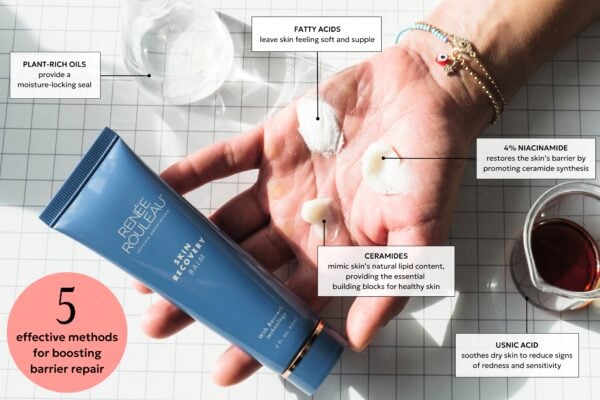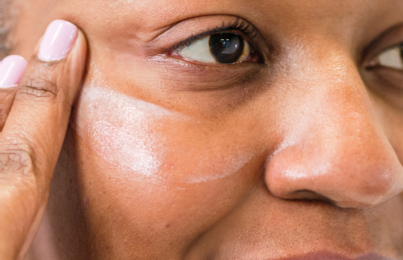Maintaining a strong and healthy skin barrier has never been more important, yet the key ingredients for skin barrier repair often don’t get the spotlight they deserve. So how are we supposed to know how to repair the skin barrier? Don’t worry, I’ll explain! Lately, there’s been a noticeable shift in skincare towards products that focus on the science of barrier repair. This trend highlights a growing awareness of the natural, effective ingredients that can truly restore and protect the skin, making it more resilient and radiant. Let’s dive into the essentials you need to know to achieve a healthier skin barrier.
- Understanding Your Skin’s Personal Bodyguard: The Moisture Barrier
- How to Repair Skin Barrier | Do’s & Dont’s
- List of Skin Barrier Repair Technologies That Actually Work
- 1. Use products containing Niacinamide at approximately 2-4%
- 2. Use products containing usnic acid (lichen extract)
- 3. Use products that contain ceramides, essential fatty acids, and fatty acids
- 4. Use products that contain plant oils rich in fatty acids and omegas
- 5. Use products with occlusive ingredients
- BONUS: Hydrating Ingredients
- How Long Does It Take to Repair Skin Barrier
- Ready! Set! Go Repair Your Skin Barrier!
Understanding Your Skin’s Personal Bodyguard: The Moisture Barrier
In case you don’t know about the skin’s barrier, here is what you first need to know.
The moisture barrier is the outermost layer of the skin that helps retain water and protects it from external aggressors, like bacteria and environmental debris. Think of it like your skin’s personal bodyguard, which helps keep the good in and the bad out. It’s made up of lipids (oils) that bind your skin cells together. When intact, it’s responsible for keeping skin feeling soft and smooth. When the moisture barrier becomes damaged (such as from over-exfoliation, retinol, and the use of harsh products), small, invisible cracks appear. Through these cracks, moisture can easily escape and irritants can easily enter. The skin may start to feel tight, dry, and sensitive. Essentially, it’s like your skin lost its protective bodyguard – and it needs to be fixed!
How to Repair Skin Barrier | Do’s & Dont’s
If you know you have a damaged skin barrier, it’s crucial to focus on gentle, hydrating skincare practices. Begin by avoiding harsh products that can cause further damage, such as strong exfoliants or high concentrations of active ingredients like retinol. Instead, opt for a gentle cleanser, hydrating toner, and barrier-repairing serums or moisturizers. Look for soothing and nourishing ingredients like ceramides, peptides, and plant oils, which help rebuild and protect the barrier. Consistency is key—regularly use these supportive products and avoid over-exfoliation. With patience and a careful routine, your skin barrier can recover, leading to healthier, more resilient skin. We’ve put together a list of specific ingredients you should look for to help restore your skin’s protective layer.
List of Skin Barrier Repair Technologies That Actually Work
From a product formulation standpoint, these are five effective ways to repair a compromised barrier that you need to know about when choosing skincare products.
1. Use products containing Niacinamide at approximately 2-4%
This versatile ingredient plays a crucial role in not just repairing the skin barrier but also promoting overall skin health. Niacinamide is most beneficial in serums or moisturizers left on the skin, so it has time to penetrate the skin’s upper layers and go to work. Read more about the benefits of Niacinamide in this post.
Benefits:
- Ceramide production
- Skin Soothing
- Balances skin microbiome
2. Use products containing usnic acid (lichen extract)
Usnic acid is a natural extract from lichens that is a gentle solution for barrier repair. It balances skin’s microbiome, leaving it feeling soothed. Usnic acid can be found in products in the form of sodium usnate or Usnea Barbata (Lichen) Extract.
Benefits:
- Barrier repairing
- Ceramide production
- Skin Soothing
- Balances skin microbiome
3. Use products that contain ceramides, essential fatty acids, and fatty acids
These ingredients work in harmony to strengthen and replenish the skin barrier, providing the essential building blocks for healthy skin. Look for ingredients like phytosphingosine, ceramide AP, and ceramide NP. Phytosterols are also great for barrier repair and very similar to ceramides as they’re part of the skin’s structure.
Benefits:
- Barrier repairing
- Skin softening
- Skin protectant
- Moisturizing
4. Use products that contain plant oils rich in fatty acids and omegas
Incorporating plant oils into our routines helps nourish the skin with essential fatty acids and omegas, promoting barrier recovery. Shea butter, jojoba oil and squalene have components similar to the structure of human sebum, making them a natural fit to protect your skin’s barrier.
Plant oils rich in omegas are Borage Oil, Evening Primrose Oil, and Flaxseed Oil.
You can either use a moisturizer full of plant oils or apply a few drops of a hydrating facial oil as the last step of your skincare routine to lock moisture in.
5. Use products with occlusive ingredients
Occlusives in skincare refer to ingredients that create a barrier on the skin’s surface, helping to prevent water loss and enhance moisture retention. It’s a common misconception that occlusive ingredients (like ceramides, squalane, and shea butter) clog pores or don’t allow your skin to breathe. Skin Recovery Balm uses Barrier5 technology to restore skin from deep within, using 5 methods of barrier repair to keep skin looking healthy and more radiant. This formula creates a protective moisture-locking seal that stays put all night long and it’s surprisingly lightweight. (Is a heavy, thick moisturizer truly the best option for dry skin? Absolutely not. Read why here.)
Look for the following occlusive ingredients when shopping for barrier-repairing products.
- Ceramides
- Squalane
- Tocopheryl Linoleate
- Phytosterols
- Sunflower Oil
- Soybean Oil
- Safflower Oil
- Jojoba Oil
- Sweet Almond Oil
- Canola Oil
- Sesame Seed Oil
- Dimethicone
BONUS: Hydrating Ingredients
While hydrating ingredients aren’t going to repair the barrier on their own, they provide a lot of additional support! Deep, long-lasting hydration provided by plant-derived humectants, like glycerin or hyaluronic acid, play a crucial role in restoring and maintaining skin health. This hydration can improve the skin’s overall appearance and function, which can indirectly support the barrier repair process.
How Long Does It Take to Repair Skin Barrier
The good news is that the skin barrier is resilient and can often recover with the right care. The time it takes to repair depends on the extent of the damage and how well you treat your skin. In mild cases, it can take as little as a few days to a week for your barrier to start feeling better. However, more severe damage may require a few weeks of consistent, gentle skincare. The key is to focus on nourishing, barrier-friendly ingredients and to avoid anything too harsh or stripping. With patience and the right approach, your skin’s protective bodyguard can be restored, leaving your skin soft, smooth, and resilient once again.
Ready! Set! Go Repair Your Skin Barrier!
As many brands tout barrier repair claims, understanding the science of how a product achieves this has grown increasingly important. Many brands will claim a moisturizer or mask will repair the barrier but it’s really important to understand how a product achieves this. I hope this has brought you some clarity when it comes to the ‘how’ of effective barrier repair. Now you can ensure your skincare choices align with the facts behind healthy, glowing skin.
Learn the many causes of a damaged barrier.
Celebrity Esthetician & Skincare Expert
As an esthetician trained in cosmetic chemistry, Renée Rouleau has spent 35 years researching skin, educating her audience, and building an award-winning line of products. Her hands-on experience as an esthetician and trusted skin care expert has created a real-world solution — products that are formulated for nine different types of skin so your face will get exactly what it needs to look and feel its best. Trusted by celebrities, editors, bloggers, and skincare obsessives around the globe, her vast real-world knowledge and constant research are why Marie Claire calls her “the most passionate skin practitioner we know.”



